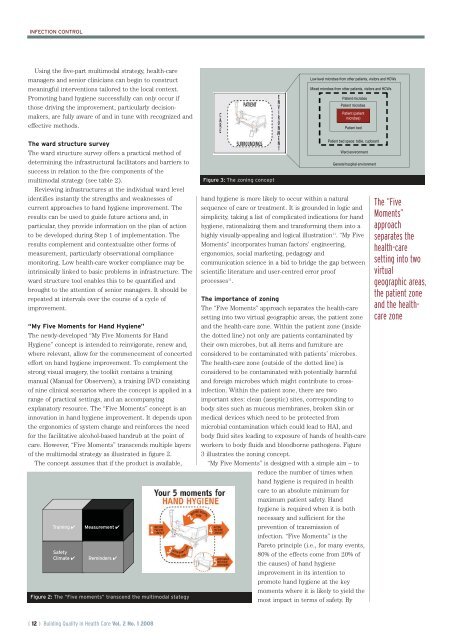The WHO multimodal hand hygiene improvement strategy
The WHO multimodal hand hygiene improvement strategy
The WHO multimodal hand hygiene improvement strategy
You also want an ePaper? Increase the reach of your titles
YUMPU automatically turns print PDFs into web optimized ePapers that Google loves.
INFECTION CONTROL<br />
Using the five-part <strong>multimodal</strong> <strong>strategy</strong>, health-care<br />
managers and senior clinicians can begin to construct<br />
meaningful interventions tailored to the local context.<br />
Promoting <strong>hand</strong> <strong>hygiene</strong> successfully can only occur if<br />
those driving the <strong>improvement</strong>, particularly decisionmakers,<br />
are fully aware of and in tune with recognized and<br />
effective methods.<br />
<strong>The</strong> ward structure survey<br />
<strong>The</strong> ward structure survey offers a practical method of<br />
determining the infrastructural facilitators and barriers to<br />
success in relation to the five components of the<br />
<strong>multimodal</strong> <strong>strategy</strong> (see table 2).<br />
Reviewing infrastructures at the individual ward level<br />
identifies instantly the strengths and weaknesses of<br />
current approaches to <strong>hand</strong> <strong>hygiene</strong> <strong>improvement</strong>. <strong>The</strong><br />
results can be used to guide future actions and, in<br />
particular, they provide information on the plan of action<br />
to be developed during Step 1 of implementation. <strong>The</strong><br />
results complement and contextualize other forms of<br />
measurement, particularly observational compliance<br />
monitoring. Low health-care worker compliance may be<br />
intrinsically linked to basic problems in infrastructure. <strong>The</strong><br />
ward structure tool enables this to be quantified and<br />
brought to the attention of senior managers. It should be<br />
repeated at intervals over the course of a cycle of<br />
<strong>improvement</strong>.<br />
“My Five Moments for Hand Hygiene”<br />
<strong>The</strong> newly-developed “My Five Moments for Hand<br />
Hygiene” concept is intended to reinvigorate, renew and,<br />
where relevant, allow for the commencement of concerted<br />
effort on <strong>hand</strong> <strong>hygiene</strong> <strong>improvement</strong>. To complement the<br />
strong visual imagery, the toolkit contains a training<br />
manual (Manual for Observers), a training DVD consisting<br />
of nine clinical scenarios where the concept is applied in a<br />
range of practical settings, and an accompanying<br />
explanatory resource. <strong>The</strong> “Five Moments” concept is an<br />
innovation in <strong>hand</strong> <strong>hygiene</strong> <strong>improvement</strong>. It depends upon<br />
the ergonomics of system change and reinforces the need<br />
for the facilitative alcohol-based <strong>hand</strong>rub at the point of<br />
care. However, “Five Moments” transcends multiple layers<br />
of the <strong>multimodal</strong> <strong>strategy</strong> as illustrated in figure 2.<br />
<strong>The</strong> concept assumes that if the product is available,<br />
Training ✔<br />
Safety<br />
Climate ✔<br />
Measurement ✔<br />
Reminders ✔<br />
Figure 2: <strong>The</strong> “Five moments” transcend the <strong>multimodal</strong> stategy<br />
Figure 3: <strong>The</strong> zoning concept<br />
Low level microbes from other patients, visitors and HCWs<br />
Mixed microbes from other patients, visitors and HCWs<br />
Patient microbes<br />
Patient microbes<br />
Patient (patient<br />
microbes)<br />
Patient bed<br />
Patient bed space: table, cupboard<br />
Ward environment<br />
General hospital environment<br />
<strong>hand</strong> <strong>hygiene</strong> is more likely to occur within a natural<br />
sequence of care or treatment. It is grounded in logic and<br />
simplicity, taking a list of complicated indications for <strong>hand</strong><br />
<strong>hygiene</strong>, rationalizing them and transforming them into a<br />
highly visually-appealing and logical illustration 11 . “My Five<br />
Moments” incorporates human factors’ engineering,<br />
ergonomics, social marketing, pedagogy and<br />
communication science in a bid to bridge the gap between<br />
scientific literature and user-centred error proof<br />
processes 11 .<br />
<strong>The</strong> importance of zoning<br />
<strong>The</strong> “Five Moments” approach separates the health-care<br />
setting into two virtual geographic areas, the patient zone<br />
and the health-care zone. Within the patient zone (inside<br />
the dotted line) not only are patients contaminated by<br />
their own microbes, but all items and furniture are<br />
considered to be contaminated with patients’ microbes.<br />
<strong>The</strong> health-care zone (outside of the dotted line) is<br />
considered to be contaminated with potentially harmful<br />
and foreign microbes which might contribute to crossinfection.<br />
Within the patient zone, there are two<br />
important sites: clean (aseptic) sites, corresponding to<br />
body sites such as mucous membranes, broken skin or<br />
medical devices which need to be protected from<br />
microbial contamination which could lead to HAI, and<br />
body fluid sites leading to exposure of <strong>hand</strong>s of health-care<br />
workers to body fluids and bloodborne pathogens. Figure<br />
3 illustrates the zoning concept.<br />
“My Five Moments” is designed with a simple aim – to<br />
reduce the number of times when<br />
<strong>hand</strong> <strong>hygiene</strong> is required in health<br />
care to an absolute minimum for<br />
maximum patient safety. Hand<br />
<strong>hygiene</strong> is required when it is both<br />
necessary and sufficient for the<br />
prevention of transmission of<br />
infection. “Five Moments” is the<br />
Pareto principle (i.e., for many events,<br />
80% of the effects come from 20% of<br />
the causes) of <strong>hand</strong> <strong>hygiene</strong><br />
<strong>improvement</strong> in its intention to<br />
promote <strong>hand</strong> <strong>hygiene</strong> at the key<br />
moments where it is likely to yield the<br />
most impact in terms of safety. By<br />
<strong>The</strong> “Five<br />
Moments”<br />
approach<br />
separates the<br />
health-care<br />
setting into two<br />
virtual<br />
geographic areas,<br />
the patient zone<br />
and the healthcare<br />
zone<br />
( 12 ) Building Quality in Health Care Vol. 2 No. 1 2008

















